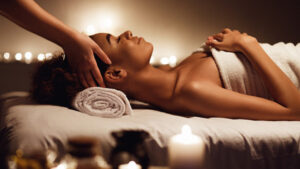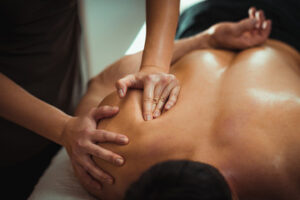Therapeutic massage focuses on healing and pain relief. It can help prevent injuries and heal them faster. It also improves sleep and boosts energy.

Despite its reputation as a self-indulgent luxury, many people find massage therapy deeply relaxing and beneficial. Visit https://www.atlasmassage.net/ to learn more.
Massage stimulates the lymphatic system and increases circulation, bringing more nutrients to tissues and organs. It also encourages the body to get rid of waste products and toxins.
Studies have shown that people who receive regular massages experience lower levels of pain and report less need for pain medication than those who do not. Some doctors even recommend massage as part of a comprehensive pain management plan for patients with chronic conditions such as rheumatoid arthritis.
Most commonly, a massage is used to relieve back and neck pain. However, the benefits of massage aren’t limited to these areas, and it can benefit many other parts of the body as well. For instance, a sports massage can help improve the range of motion of joints affected by injury. In addition, a deep-tissue massage can reduce the tension that builds in muscles after a hard workout.
A massage can help to calm the fight-or-flight response that triggers panic attacks in some people. By calming this reaction, a massage can be beneficial to those who suffer from anxiety and depression, as well as those with a history of trauma or abuse. In addition, a relaxing massage can be helpful in improving a person’s mood and reducing stress levels, which can contribute to anxiety.
According to the gate control theory of pain, a noxious stimulus passes through a series of gates before reaching the brain. Some gates transmit the noxious sensation, while others inhibit it. The hypothesis is that massage therapy can close the gates by stimulating large nerve fibers that compete with pain signals, thus altering perceptions of pain.
In one study, massage reduced a patient’s reliance on pain medications and increased their functioning ability. The researchers recommended that massage should be integrated into standard hospital care. This is an exciting development, and it would be great if more medical professionals started to incorporate this type of treatment into their arsenals to help manage the pain associated with many conditions. Until then, it’s important to talk with your rheumatologist or primary care physician before getting a massage.
Increases Circulation
One of the many things massage is known to do is improve circulation. This is believed to be due to both the physical manipulation of soft tissue and chemicals released as part of the body’s relaxation response. Increased circulation can enhance the delivery of oxygen and nutrients to muscle cells, resulting in improved cellular health and the removal of metabolic wastes.
In addition, the vasodilation produced by massage helps to improve circulation by widening blood vessels and reducing their resistance. This, in turn, can help to reduce the buildup of lactic acid and other waste products within muscles and in joints.
It is important to note, however, that while most massage techniques aid circulation in some way, some methods are more effective than others at improving blood flow. For instance, if a therapist massages your arms and pushes all the glides down into your fingers, this will not be helpful for your circulation. The lymph nodes in your fingers are not able to neutralize the excess fluid, and it will simply start to build up in the joints of your arms and hands. In order to get a good, deep circulation boost from your massage, it is important to ensure that all glides are working their way up towards the heart.
Another excellent way to boost your circulation is to exercise regularly. Even a walk around the mall or workout at your gym can be great for you and your circulation!
It is also worth noting that the chest compressions used in cardiopulmonary resuscitation (the “CPR”) can actually move a lot of blood. This is because the pressure that is applied to the chest — literally squishing it with your hands to passively simulate a heartbeat — can actually increase circulation enough to be helpful. So, if you are trying to use your massage to save a life, do not skip the chest compressions! But if you want to see a real, significant increase in your circulation, try out some regular, intense cardiovascular exercise. It’ll be better for you in the long run!
Relaxes Muscles
A massage helps maintain healthy muscles by increasing oxygenation to the tissues and decreasing muscle fatigue. Oxygen is used by muscle cells for energy and is important for cellular exchange. A lack of oxygen results in fatigued and weak muscles which can lead to injury. Massage increases blood flow bringing in more oxygen to the muscles. Massage also reduces the build-up of waste products allowing your body to eliminate them efficiently.
Muscle tightness is a form of hypertonicity which can cause imbalance in the body. Tight muscles can pull posture out of alignment, restrict movement and constrict blood flow. Massages relieve tightness by reducing the high tone in the muscle fibres and increasing elasticity in the tissue.
Tight muscles are able to develop knots which increase pain and restriction, and massages break down these adhesions. The pressure and kneading movements in massages realign the muscle fibres back to their normal plane of motion. This decreases the tightness of the muscles and reduces the occurrence of muscle injuries during exercise or pre event training.
After a massage it is recommended to relax and rest for an hour or so. It is important to avoid anything too strenuous such as a heavy workout or vigorous activity. This is because the muscles have just been manipulated and the body may need time to get back to its normal state.
Showering after a massage is also not recommended because the moisture could cause further irritation to the muscle fibres. Ideally, you should wait to shower until about an hour after your massage to allow the skin to properly absorb the oils and lotions used in the treatment.
In the days after your massage it is recommended to drink plenty of water and eat light foods such as fruits and vegetables. This will help keep your immune system strong and prevent inflammation after the session. This will help you recover faster and maintain a healthy lifestyle. This is especially important during the week following your massage to ensure you are able to reap the benefits and maintain the results that you have gained from the therapy.
Relieves Anxiety
Most people are aware that massage relieves muscle soreness and promotes blood flow, but many don’t realize it can help alleviate anxiety. Anxiety is one of the most common mental health issues, yet it is often overlooked. Many people who suffer from it do not seek treatment because they think their symptoms are not severe enough, or they believe there is nothing that can be done to help them feel better.
But studies show that massage has powerful effects on the nervous system, decreasing stress hormones and increasing “happy” chemicals that make you feel good. The act of receiving a massage triggers the body to release endorphins, natural mood enhancers that boost feelings of happiness and euphoria and reduce pain. Massage also helps activate the parasympathetic nervous system, which slows the heart rate and reduces stress levels.
During massage, the brain sends messages to the body to increase temperature, which causes the blood vessels to expand, and increases circulation. This allows oxygen to reach the tissues and cells, removing waste products and reducing tension. It also helps to decrease the heart rate and blood pressure, which further decreases stress levels.
Anxiety can have a number of physical symptoms, including tight muscles and headaches. In addition to relieving headaches, massage can ease the stress-related neck and back pain that often accompanies anxiety. Massage also helps to loosen tense muscles and joints, which can improve posture and lead to a general sense of relaxation.
A study comparing the effects of massage to standard medical care on chronic pain conditions found that patients who received massage experienced improvements in all three of the outcomes measured: pain intensity, depression and anxiety. In fact, the reductions in pain and anxiety were maintained at a three-month follow-up.
Another study compared the effect of two different types of massage to each other on immediate anxiety levels and intermediate-term occupational stress. This study was limited by problems with recruitment and randomization, but it still showed that hand massage significantly reduced anxiety in emergency nurses during both summer and winter, as well as decreasing sick leave and workload.
